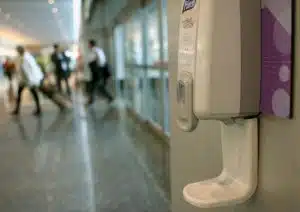
Uses at the WorkPlace
Should hand cleansers be a priority over doing an Antigen check in the workplace? Will this help mitigate the effects of the HPV or Sars virus diseases? Look at it this way: if you have just five employees who use different computers daily, the risk of contamination increases. In addition, these five will feel obligated to shake hands with their colleagues, further increasing the risk of Covid-19. Remember that 80% of germs that spread in the workplace result from handshakes. It results in a loss of more than 225 billion dollars worth of productivity.
HPV kits also indicate that virus spreading by hand-to-hand contact is also occurring. Thus, getting a PCR testing kit should be a standard process in the workplace. Alongside an antigen testing kit, there are a whole range of options. Folks can get a full allergy profile done at least once in their lifetime to understand if they are allergic to anything.
In addition, sanitisers should be used where the hands are not visibly dirty.

One way to ensure people sanitise regularly is to have hand sanitiser booths in the hallway near a clinic that sells PCR testing kits and allergy profiles.
Critical Locations of Placing Sterilizer
According to a recent Infectious Disease Institute laboratory study, office workers who did not use sterilisers were five times more likely to get sick, with positive results while taking an HPV PCR testing kit. However, when a full allergy profile test was done, some people were seen to be allergic to sanitisers. In addition, the organisation that promoted the use of this product was more productive. The best way to encourage people to use antiseptics is to release them in readily accessible and noticeable areas. Similarly, the product should have the right alcohol content to be effective and not damage the skin. Employees should place disinfectants in these places:
Entrance and Exits
Employees often touch doorknobs while working in offices. Experts say the coronavirus can stay on the surface for 3-6 hours and in the air for more than 3 hours, which is why all employees should wear face masks. Employers regularly use a sanitiser or alcohol solution near switches and stairs. Employees must also sanitise their hands before administering an antigen or allergy test.
Break rooms and Food Courts
Another place where the HPV pathogen can quickly spread is the food court. This place has high traffic, and most people touch cups and plates. However, the World Health Organization advises using soap and water rather than alcohol disinfectants in food courts. Disinfectants should only be used where soap is not available. Soap is an alternative for disinfectants before an allergy or antigen test. Being aware helps.
Employee Desks
Employees spend most of their time at their desks. They eat, drink, and cough, which potentially transmits their saliva. It can be very tricky to contain at times.
High Traffic Areas
Booths can also be placed near high-traffic areas such as elevators and parking lots. This will prevent bacteria from entering or leaving the building. People can also quickly sanitise their hands at these booths on their way to a clinic for an allergy test.
Have Employee Education Programs virus transmission.
Placing a hand gel without educating your employees is not helpful. The best approach would be to educate them on the importance of disinfectants, how to use them regularly, and regular HPV tests. Most employees do not know how to wash their hands properly. It may result in the spread of germs. Take antigen examinations from time to time. Do an allergy test at least once in your life. Stay safe and stay healthy and happy. Stay clean.
